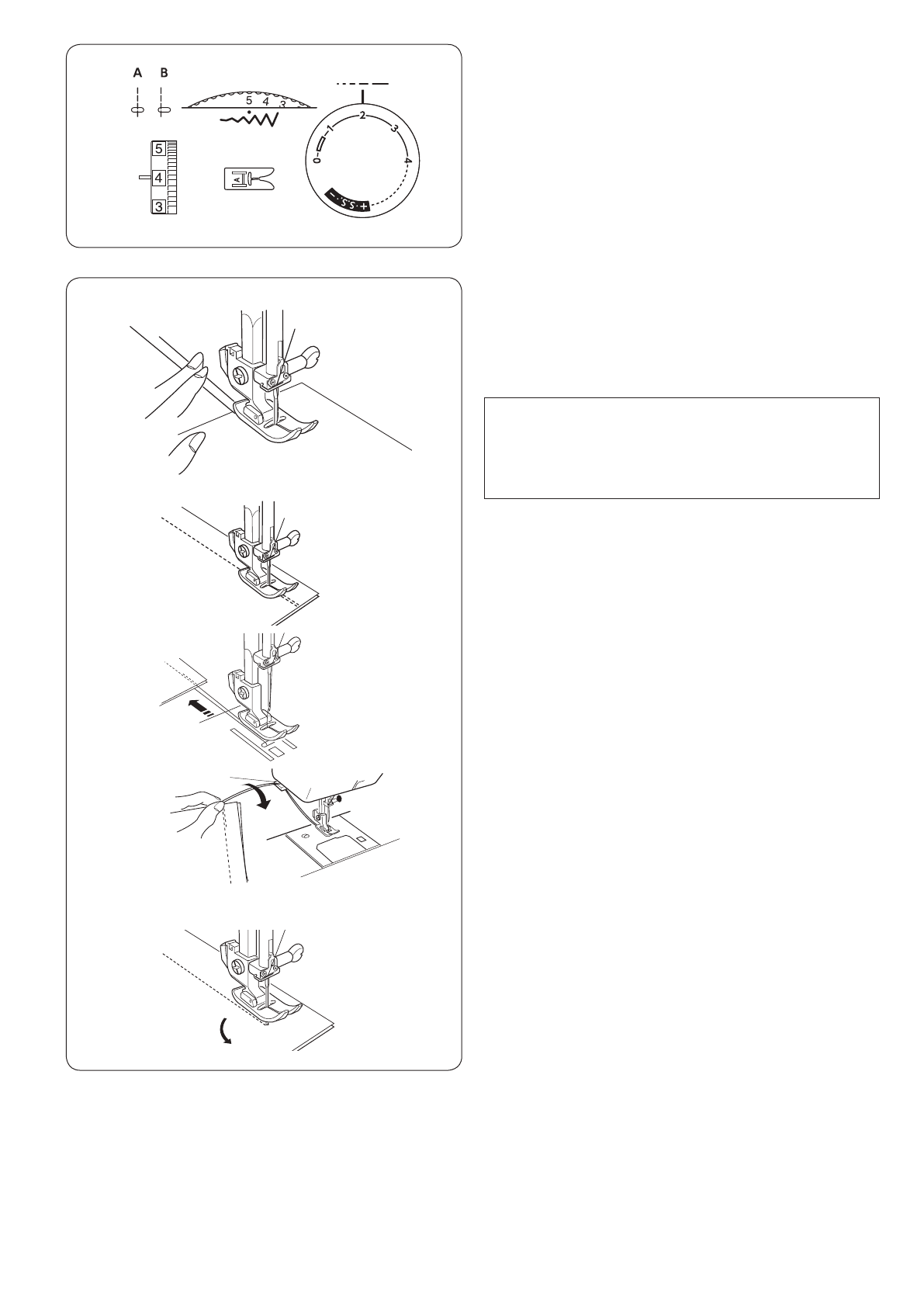Швейная машина Janome Clio 320 - инструкция пользователя по применению, эксплуатации и установке на русском языке. Мы надеемся, она поможет вам решить возникшие у вас вопросы при эксплуатации техники.
Если остались вопросы, задайте их в комментариях после инструкции.
"Загружаем инструкцию", означает, что нужно подождать пока файл загрузится и можно будет его читать онлайн. Некоторые инструкции очень большие и время их появления зависит от вашей скорости интернета.

19
РАЗДЕЛ 3.
ОСНОВНЫЕ ШВЕЙНЫЕ ТЕХНИКИ
Прямой стежок
Установки машины
q
Выбор строчки:
А
w
Ширина зигзага:
0 или 5
e
Длина стежка:
1.5 – 4
r
Натяжение нити: 2 – 6
t
Прижимная лапка: Лапка А для зигзага
Начало работы
Поднимите прижимную лапку и расположите ткань
под лапкой.
Опустите иглу в ткань.
Опустите прижимную лапку и отведите нити назад.
Нажмите на ножную педаль.
* При работе с лёгкими и тонкими тканями
допускается визуальное отклонение прямой
строчки по косой.
Изменение направления строчки
Остановите машину, поверните на себя маховое
колесо и опустите иглу в ткань.
Поднимите прижимную лапку.
Поверните ткань вокруг иглы и смените по желанию
направление строчки. Опустите прижимную лапку
и продолжайте работать.
Завершение строчки
Для закрепления конца строчки нажмите на кнопку
реверса и прошейте несколько обратных стежков
в конце шва.
Поднимите прижимную лапку и снимите ткань,
отведя нити назад.
Подведите нити вверх к нитебрезателю. Обрезайте
нити на достаточной длине для начала нового шва.
q
Нитеобрезатель
19
BASIC SEWING
Straight Stitch Sewing
q
Stitch pattern:
A / B
w
Stitch width:
0 or 5
e
Stitch length:
1.5 – 4
r
Thread tension:
2 – 6
t
Presser foot:
Zigzag foot A
Starting to sew
Raise the presser foot and place the fabric under
the foot.
Lower the needle into the fabric.
Lower the presser foot and smooth the threads
toward the back. Depress the foot control.
NOTE:
Draw the threads to the left when sewing with
the buttonhole foot B or automatic buttonhole
foot R.
To fasten the beginning of the seam, first sew
several stitches in reverse then sew forward.
q
w
e
r
t
Finishing sewing
Press the reverse stitch lever and sew several
stitches in reverse at the end of the seam.
q
Changing the sewing direction
Stop the machine and turn the handwheel
toward you to bring the needle down into the
fabric.
Raise the presser foot.
Pivot the fabric around the needle to change
sewing direction as desired. Lower the presser
foot and continue sewing in the new direction.
Raise the presser foot and remove the fabric,
drawing the threads to the back.
Draw the threads up and into the thread cutter.
The threads are cut the proper length for starting
the next seam.
q
Thread cutter
19
BASIC SEWING
Straight Stitch Sewing
q
Stitch pattern:
A / B
w
Stitch width:
0 or 5
e
Stitch length:
1.5 – 4
r
Thread tension:
2 – 6
t
Presser foot:
Zigzag foot A
Starting to sew
Raise the presser foot and place the fabric under
the foot.
Lower the needle into the fabric.
Lower the presser foot and smooth the threads
toward the back. Depress the foot control.
NOTE:
Draw the threads to the left when sewing with
the buttonhole foot B or automatic buttonhole
foot R.
To fasten the beginning of the seam, first sew
several stitches in reverse then sew forward.
q
w
e
r
t
Finishing sewing
Press the reverse stitch lever and sew several
stitches in reverse at the end of the seam.
q
Changing the sewing direction
Stop the machine and turn the handwheel
toward you to bring the needle down into the
fabric.
Raise the presser foot.
Pivot the fabric around the needle to change
sewing direction as desired. Lower the presser
foot and continue sewing in the new direction.
Raise the presser foot and remove the fabric,
drawing the threads to the back.
Draw the threads up and into the thread cutter.
The threads are cut the proper length for starting
the next seam.
q
Thread cutter
ПРИМЕЧАНИЕ:
При работе с лапкой для петли отводите нити
влево. Для закрепления начала строчки сделайте
несколько стежков реверса, а затем продолжайте
строчить вперед.
23
Прямой стежок стрейч
Установки машины
q
Выбор строчки:
А/В
w
Ширина зигзага:
0 или 5
e
Длина стежка:
S.S.
r
Натяжение нити:
2 – 5
t
Прижимная лапка: Лапка А для зигзага
Эта строчка формируется из двух стежков вперёд
и одного назад. Такой шов нелегко разорвать.
Используйте его в области проймы и втачивания
рукавов.
Можно также использовать при шитье рюкзаков.
Слегка направляйте ткань во время работы, т.к. она
постоянно двигается вперёд-назад.
Стежок стрейч зигзаг
Установки машины
q
Выбор строчки:
C
w
Ширина зигзага:
2 – 5
e
Длина стежка:
S.S.
r
Натяжение нити:
2 – 5
t
Прижимная лапка: Лапка А для зигзага
С помощью этого стежка возможно обрабатывать
ткани стрейч там, где необходим зигзаг.
Также его можно использовать как декоративную
отделку.
23
Straight Stretch Stitch
q
Stitch pattern:
A / B
w
Stitch width:
0 or 5
e
Stitch length:
S.S.
r
Thread tension:
2 – 5
t
Presser foot:
Zigzag foot A
Zigzag Stretch Stitch
q
Stitch pattern:
C
w
Stitch width:
2 – 5
e
Stitch length:
S.S.
r
Thread tension:
2 – 5
t
Presser foot:
Zigzag foot A
q
q
w
w
e
e
r
r
t
t
The pattern is sewn with two stitches forward
and one stitch backward, forming a seam that
does not rip easily.
Use it to reinforce areas such as crotch and
armhole seams.
Also use it when constructing items such as
backpacks for extra strength.
Carefully guide the fabric while sewing as the
fabric moves back and forth.
Sew on stretch fabrics in any area that you might
use a zigzag stitch.
This stitch is used as a decorative topstitch as
well.
23
Straight Stretch Stitch
q
Stitch pattern:
A / B
w
Stitch width:
0 or 5
e
Stitch length:
S.S.
r
Thread tension:
2 – 5
t
Presser foot:
Zigzag foot A
Zigzag Stretch Stitch
q
Stitch pattern:
C
w
Stitch width:
2 – 5
e
Stitch length:
S.S.
r
Thread tension:
2 – 5
t
Presser foot:
Zigzag foot A
q
q
w
w
e
e
r
r
t
t
The pattern is sewn with two stitches forward
and one stitch backward, forming a seam that
does not rip easily.
Use it to reinforce areas such as crotch and
armhole seams.
Also use it when constructing items such as
backpacks for extra strength.
Carefully guide the fabric while sewing as the
fabric moves back and forth.
Sew on stretch fabrics in any area that you might
use a zigzag stitch.
This stitch is used as a decorative topstitch as
well.
23
Straight Stretch Stitch
q
Stitch pattern:
A / B
w
Stitch width:
0 or 5
e
Stitch length:
S.S.
r
Thread tension:
2 – 5
t
Presser foot:
Zigzag foot A
Zigzag Stretch Stitch
q
Stitch pattern:
C
w
Stitch width:
2 – 5
e
Stitch length:
S.S.
r
Thread tension:
2 – 5
t
Presser foot:
Zigzag foot A
q
q
w
w
e
e
r
r
t
t
The pattern is sewn with two stitches forward
and one stitch backward, forming a seam that
does not rip easily.
Use it to reinforce areas such as crotch and
armhole seams.
Also use it when constructing items such as
backpacks for extra strength.
Carefully guide the fabric while sewing as the
fabric moves back and forth.
Sew on stretch fabrics in any area that you might
use a zigzag stitch.
This stitch is used as a decorative topstitch as
well.
23
Straight Stretch Stitch
q
Stitch pattern:
A / B
w
Stitch width:
0 or 5
e
Stitch length:
S.S.
r
Thread tension:
2 – 5
t
Presser foot:
Zigzag foot A
Zigzag Stretch Stitch
q
Stitch pattern:
C
w
Stitch width:
2 – 5
e
Stitch length:
S.S.
r
Thread tension:
2 – 5
t
Presser foot:
Zigzag foot A
q
q
w
w
e
e
r
r
t
t
The pattern is sewn with two stitches forward
and one stitch backward, forming a seam that
does not rip easily.
Use it to reinforce areas such as crotch and
armhole seams.
Also use it when constructing items such as
backpacks for extra strength.
Carefully guide the fabric while sewing as the
fabric moves back and forth.
Sew on stretch fabrics in any area that you might
use a zigzag stitch.
This stitch is used as a decorative topstitch as
well.
Содержание
- 5 ОСНОВНЫЕ ЧАСТИ; Названия частей; ESSENTIAL PARTS; Names of Parts
- 6 Отсек для хранения аксессуаров; Standard Accessories
- 7 Съёмный столик; Чтобы установить столик:; Сопоставьте выступы с отверстиями на машине; Свободный рукав; Extension Table; q w
- 8 Operating Instructions:; Controlling the Sewing Speed; Connecting the Power Supply; GETTING READY TO SEW; Foot control; ПОДГОТОВКА К ШИТЬЮ; Подключение машины к сети; Педаль
- 9 Установочная отметка; Отключение нижнего транспортёра ткани; Рычаг нижнего транспортёра ткани
- 10 Как отстегнуть лапку:; Raising and Lowering the Presser Foot
- 11 Держатель лапки; Чтобы снять держатель лапки:; Замена игл
- 12 Установка катушки; Дополнительный катушечный стержень; Удаление шпульки; Extra spool pin; Extra spool pin
- 13 Намотка шпульки; Winding the bobbin
- 14 the thread to the left, sliding it between the
- 15 Заправка верхней нити; Как заправить игольную нить:; Threading the Machine
- 16 Нитевдеватель; Needle threader
- 17 Pull 4 ̋ (10 cm) of both threads back and
- 18 Stitch pattern selector dial
- 19 Регулятор изменения ширины зигзага; Различные положения иглы
- 20 Баланс натяжения верхней нити; Диск натяжения нити; Сбалансированное натяжение:; Balancing Needle Thread Tension
- 21 ОСНОВНЫЕ ШВЕЙНЫЕ ТЕХНИКИ; Прямой стежок; Начало работы; Starting to sew; BASIC SEWING; To fasten the beginning of the seam, first sew; Прямой стежок стрейч
- 22 Направительные линии; Обработка прямых углов; Направитель для прямых углов; The cornering guide helps you maintain a 5/8 ̋; The cornering guide helps you maintain a 5/8 ̋
- 23 ДОПОЛНИТЕЛЬНЫЕ ТЕХНИКИ; Зигзаг; Обметочный стежок; Установки машины; UTILITY STITCHES
- 24 Трикотажный стежок; This stitch is used to finish a raw edge on; This stitch is used to finish a raw edge on; Knit Stitch; This stitch is used to finish a raw edge on; Knit Stitch; This stitch is used to finish a raw edge on
- 25 Стежок стрейч зигзаг
- 27 To adjust buttonhole stitch density:
- 28 Зажгутованная петля; Corded Buttonhole
- 29 Втачивание молнии; Установка лапки для молнии; e r; Zipper Application; Fabric preparation; Zipper Application; e r; Fabric preparation
- 30 Stop the machine 2 ̋ (5 cm) before reaching
- 33 ДЕКОРАТИВНЫЕ СТРОЧКИ; Декоративные атласные строчки; Decorative Satin Stitches; Decorative Stretch Stitches
- 34 DECORATIVE STITCHES; DECORATIVE STITCHES; Smocking; DECORATIVE STITCHES; Smocking; DECORATIVE STITCHES; Smocking; DECORATIVE STITCHES; Smocking; DECORATIVE STITCHES; Smocking; DECORATIVE STITCHES; Smocking; DECORATIVE STITCHES
- 35 Узкие складки
- 37 После работы установите давление лапки на «3».; Аппликация
- 38 УХОД ЗА МАШИНОЙ; Чистка челнока и транспортёра ткани; Wipe the hook race with a soft, dry cloth.; CARE AND MAINTENANCE; Cleaning the Hook Race and Feed Dog
- 39 Make sure the knob of the bobbin holder fits
- 41 Куәлік нөмірі
























































